BBC Organisational Behaviour: Culture, Motivation and Teamwork
VerifiedAdded on 2024/05/30
|26
|4886
|319
Report
AI Summary
This report provides an in-depth analysis of organisational behaviour at the BBC, utilising various theoretical frameworks to understand its culture, politics, motivation strategies, and team dynamics. It begins by examining the BBC's organisational culture through Handy's cultural typology, highlighting issues such as hierarchies, centralisation, child abuse cases, bullying, harassment, gender discrimination, and pay gaps. The report then delves into motivation theories, including Maslow's hierarchy of needs and expectancy theory, to address the demotivation and reduced productivity among BBC staff. Furthermore, it explores team development using Tuckman and Jensen’s model, emphasising the importance of social teams and problem-solving teams to improve collaboration and address employee complaints. The analysis concludes by stressing the significance of a supportive and transparent organisational culture in enhancing team and individual performance, ultimately aligning individual goals with organisational objectives and fostering a comfortable working environment free from discrimination and biases.

ORGANISATIONAL
BEHAVIOUR
BEHAVIOUR
Paraphrase This Document
Need a fresh take? Get an instant paraphrase of this document with our AI Paraphraser
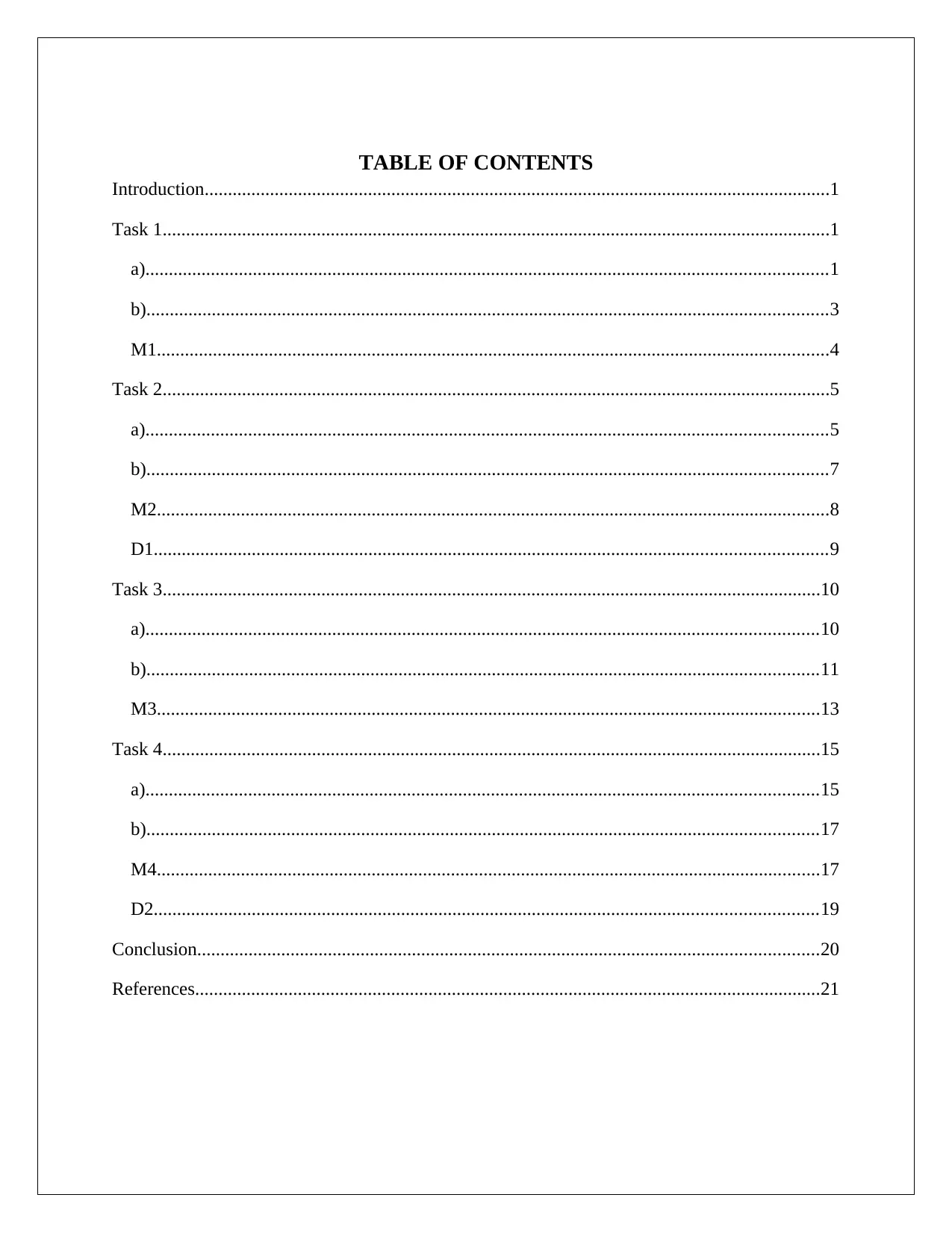
TABLE OF CONTENTS
Introduction......................................................................................................................................1
Task 1...............................................................................................................................................1
a)..................................................................................................................................................1
b)..................................................................................................................................................3
M1................................................................................................................................................4
Task 2...............................................................................................................................................5
a)..................................................................................................................................................5
b)..................................................................................................................................................7
M2................................................................................................................................................8
D1................................................................................................................................................9
Task 3.............................................................................................................................................10
a)................................................................................................................................................10
b)................................................................................................................................................11
M3..............................................................................................................................................13
Task 4.............................................................................................................................................15
a)................................................................................................................................................15
b)................................................................................................................................................17
M4..............................................................................................................................................17
D2..............................................................................................................................................19
Conclusion.....................................................................................................................................20
References......................................................................................................................................21
Introduction......................................................................................................................................1
Task 1...............................................................................................................................................1
a)..................................................................................................................................................1
b)..................................................................................................................................................3
M1................................................................................................................................................4
Task 2...............................................................................................................................................5
a)..................................................................................................................................................5
b)..................................................................................................................................................7
M2................................................................................................................................................8
D1................................................................................................................................................9
Task 3.............................................................................................................................................10
a)................................................................................................................................................10
b)................................................................................................................................................11
M3..............................................................................................................................................13
Task 4.............................................................................................................................................15
a)................................................................................................................................................15
b)................................................................................................................................................17
M4..............................................................................................................................................17
D2..............................................................................................................................................19
Conclusion.....................................................................................................................................20
References......................................................................................................................................21
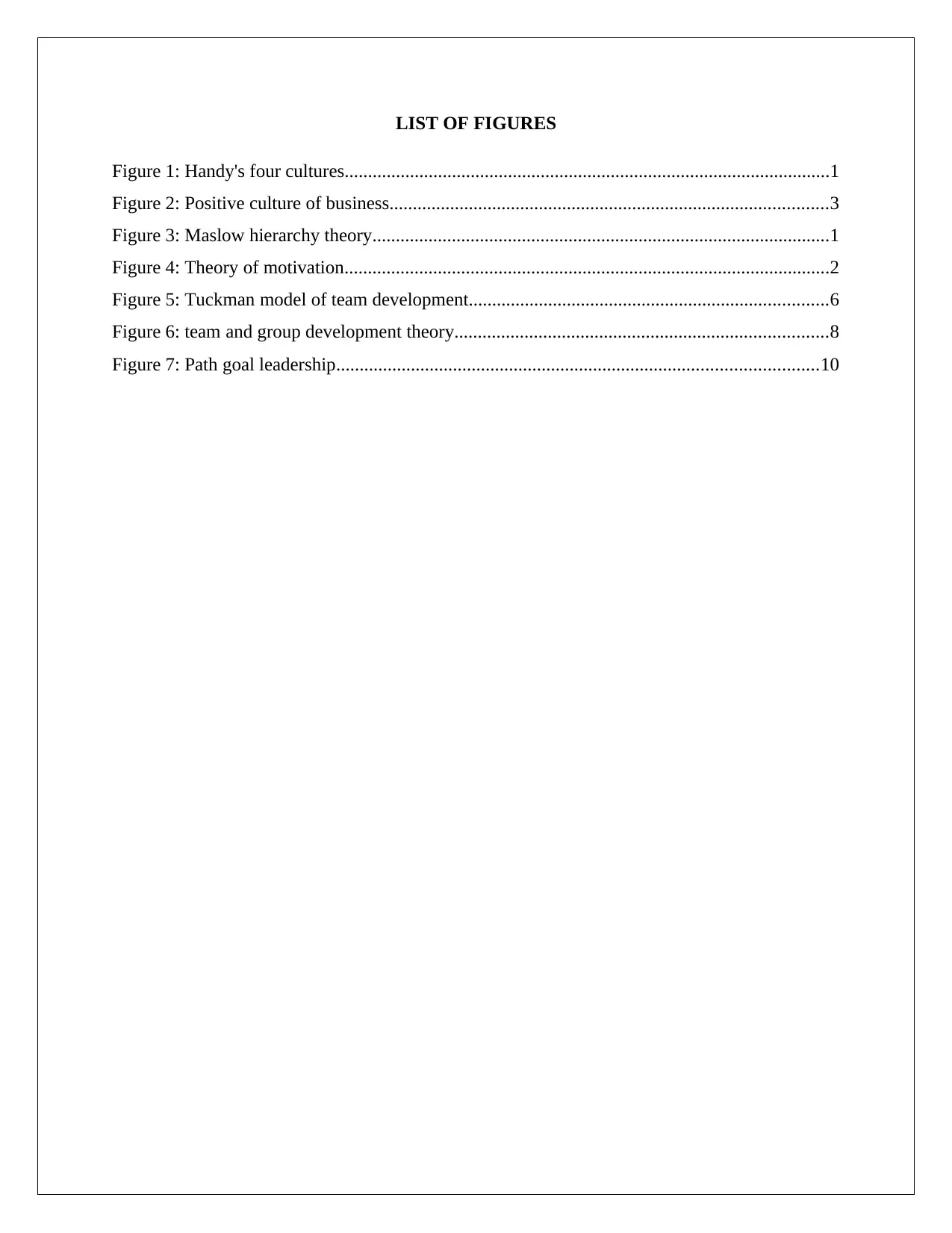
LIST OF FIGURES
Figure 1: Handy's four cultures........................................................................................................1
Figure 2: Positive culture of business..............................................................................................3
Figure 3: Maslow hierarchy theory..................................................................................................1
Figure 4: Theory of motivation........................................................................................................2
Figure 5: Tuckman model of team development.............................................................................6
Figure 6: team and group development theory................................................................................8
Figure 7: Path goal leadership.......................................................................................................10
Figure 1: Handy's four cultures........................................................................................................1
Figure 2: Positive culture of business..............................................................................................3
Figure 3: Maslow hierarchy theory..................................................................................................1
Figure 4: Theory of motivation........................................................................................................2
Figure 5: Tuckman model of team development.............................................................................6
Figure 6: team and group development theory................................................................................8
Figure 7: Path goal leadership.......................................................................................................10
⊘ This is a preview!⊘
Do you want full access?
Subscribe today to unlock all pages.

Trusted by 1+ million students worldwide
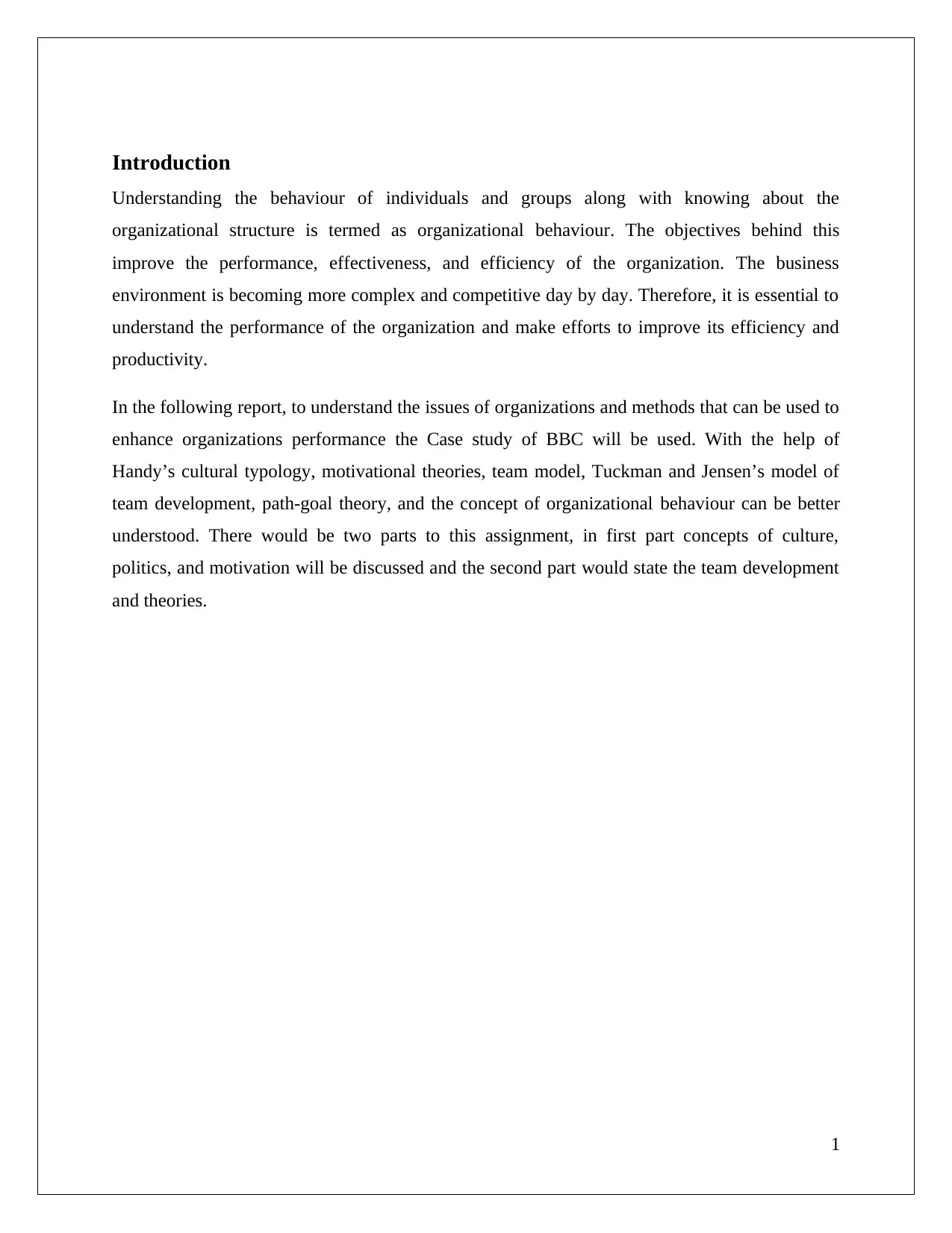
Introduction
Understanding the behaviour of individuals and groups along with knowing about the
organizational structure is termed as organizational behaviour. The objectives behind this
improve the performance, effectiveness, and efficiency of the organization. The business
environment is becoming more complex and competitive day by day. Therefore, it is essential to
understand the performance of the organization and make efforts to improve its efficiency and
productivity.
In the following report, to understand the issues of organizations and methods that can be used to
enhance organizations performance the Case study of BBC will be used. With the help of
Handy’s cultural typology, motivational theories, team model, Tuckman and Jensen’s model of
team development, path-goal theory, and the concept of organizational behaviour can be better
understood. There would be two parts to this assignment, in first part concepts of culture,
politics, and motivation will be discussed and the second part would state the team development
and theories.
1
Understanding the behaviour of individuals and groups along with knowing about the
organizational structure is termed as organizational behaviour. The objectives behind this
improve the performance, effectiveness, and efficiency of the organization. The business
environment is becoming more complex and competitive day by day. Therefore, it is essential to
understand the performance of the organization and make efforts to improve its efficiency and
productivity.
In the following report, to understand the issues of organizations and methods that can be used to
enhance organizations performance the Case study of BBC will be used. With the help of
Handy’s cultural typology, motivational theories, team model, Tuckman and Jensen’s model of
team development, path-goal theory, and the concept of organizational behaviour can be better
understood. There would be two parts to this assignment, in first part concepts of culture,
politics, and motivation will be discussed and the second part would state the team development
and theories.
1
Paraphrase This Document
Need a fresh take? Get an instant paraphrase of this document with our AI Paraphraser
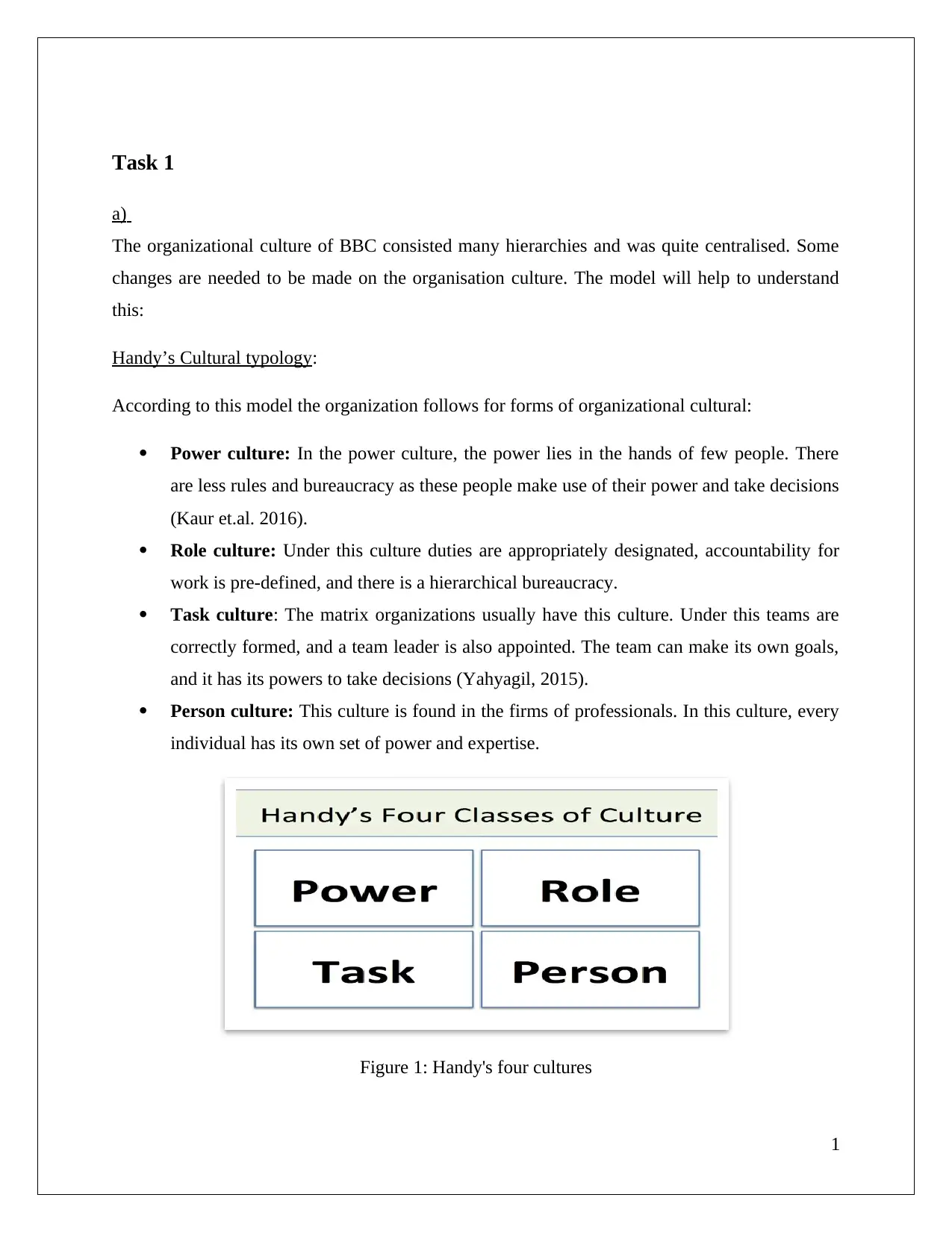
Task 1
a)
The organizational culture of BBC consisted many hierarchies and was quite centralised. Some
changes are needed to be made on the organisation culture. The model will help to understand
this:
Handy’s Cultural typology:
According to this model the organization follows for forms of organizational cultural:
Power culture: In the power culture, the power lies in the hands of few people. There
are less rules and bureaucracy as these people make use of their power and take decisions
(Kaur et.al. 2016).
Role culture: Under this culture duties are appropriately designated, accountability for
work is pre-defined, and there is a hierarchical bureaucracy.
Task culture: The matrix organizations usually have this culture. Under this teams are
correctly formed, and a team leader is also appointed. The team can make its own goals,
and it has its powers to take decisions (Yahyagil, 2015).
Person culture: This culture is found in the firms of professionals. In this culture, every
individual has its own set of power and expertise.
Figure 1: Handy's four cultures
1
a)
The organizational culture of BBC consisted many hierarchies and was quite centralised. Some
changes are needed to be made on the organisation culture. The model will help to understand
this:
Handy’s Cultural typology:
According to this model the organization follows for forms of organizational cultural:
Power culture: In the power culture, the power lies in the hands of few people. There
are less rules and bureaucracy as these people make use of their power and take decisions
(Kaur et.al. 2016).
Role culture: Under this culture duties are appropriately designated, accountability for
work is pre-defined, and there is a hierarchical bureaucracy.
Task culture: The matrix organizations usually have this culture. Under this teams are
correctly formed, and a team leader is also appointed. The team can make its own goals,
and it has its powers to take decisions (Yahyagil, 2015).
Person culture: This culture is found in the firms of professionals. In this culture, every
individual has its own set of power and expertise.
Figure 1: Handy's four cultures
1
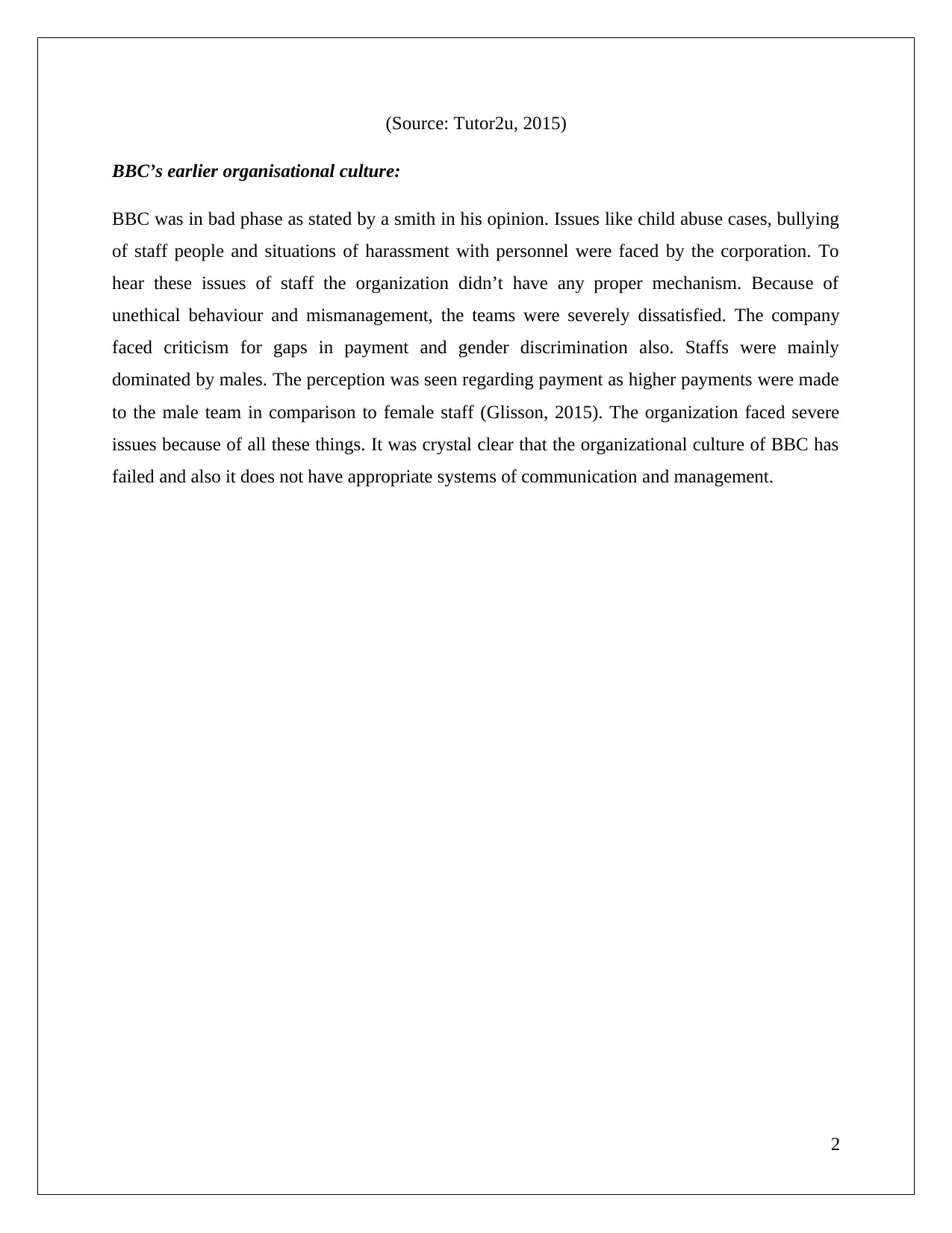
(Source: Tutor2u, 2015)
BBC’s earlier organisational culture:
BBC was in bad phase as stated by a smith in his opinion. Issues like child abuse cases, bullying
of staff people and situations of harassment with personnel were faced by the corporation. To
hear these issues of staff the organization didn’t have any proper mechanism. Because of
unethical behaviour and mismanagement, the teams were severely dissatisfied. The company
faced criticism for gaps in payment and gender discrimination also. Staffs were mainly
dominated by males. The perception was seen regarding payment as higher payments were made
to the male team in comparison to female staff (Glisson, 2015). The organization faced severe
issues because of all these things. It was crystal clear that the organizational culture of BBC has
failed and also it does not have appropriate systems of communication and management.
2
BBC’s earlier organisational culture:
BBC was in bad phase as stated by a smith in his opinion. Issues like child abuse cases, bullying
of staff people and situations of harassment with personnel were faced by the corporation. To
hear these issues of staff the organization didn’t have any proper mechanism. Because of
unethical behaviour and mismanagement, the teams were severely dissatisfied. The company
faced criticism for gaps in payment and gender discrimination also. Staffs were mainly
dominated by males. The perception was seen regarding payment as higher payments were made
to the male team in comparison to female staff (Glisson, 2015). The organization faced severe
issues because of all these things. It was crystal clear that the organizational culture of BBC has
failed and also it does not have appropriate systems of communication and management.
2
⊘ This is a preview!⊘
Do you want full access?
Subscribe today to unlock all pages.

Trusted by 1+ million students worldwide
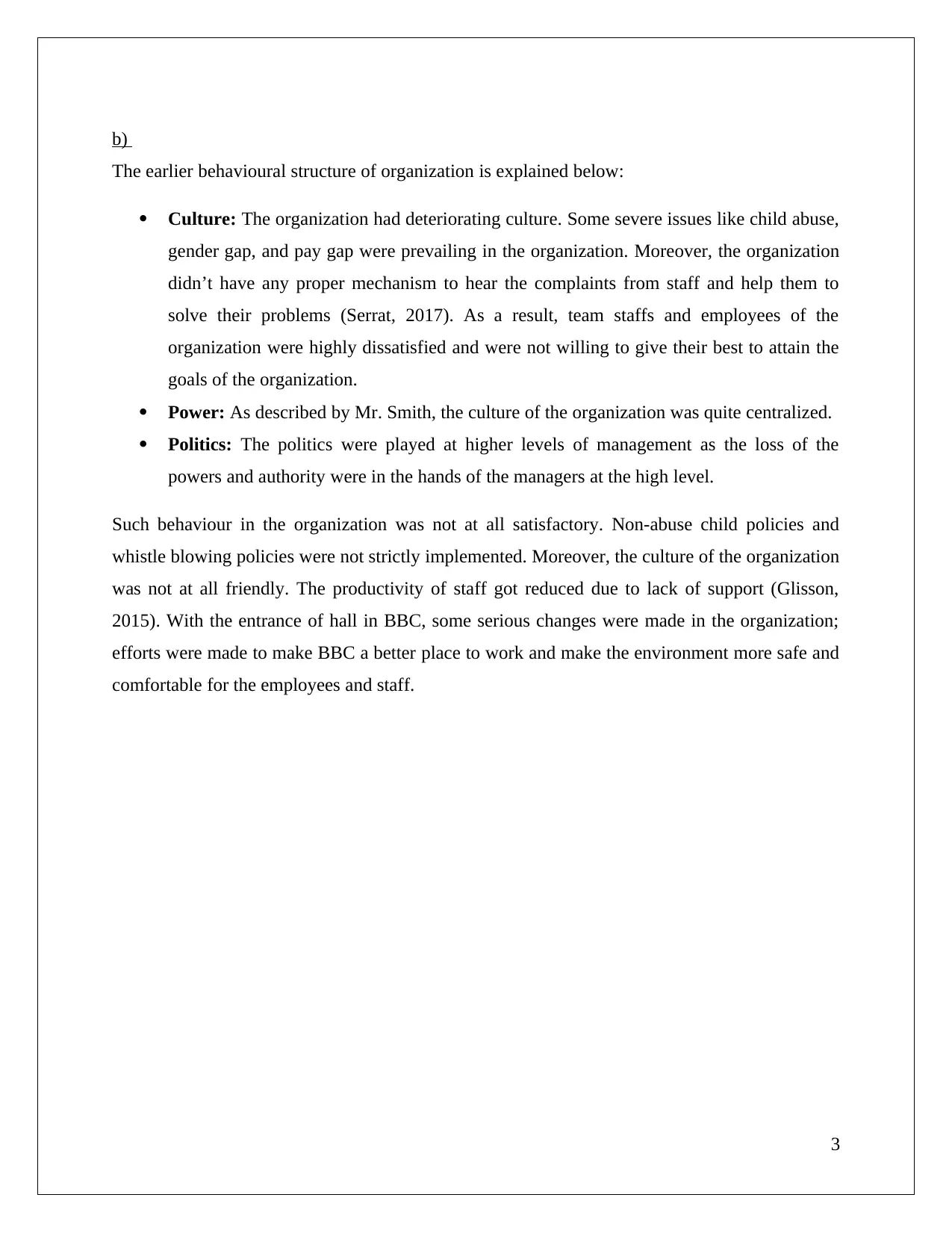
b)
The earlier behavioural structure of organization is explained below:
Culture: The organization had deteriorating culture. Some severe issues like child abuse,
gender gap, and pay gap were prevailing in the organization. Moreover, the organization
didn’t have any proper mechanism to hear the complaints from staff and help them to
solve their problems (Serrat, 2017). As a result, team staffs and employees of the
organization were highly dissatisfied and were not willing to give their best to attain the
goals of the organization.
Power: As described by Mr. Smith, the culture of the organization was quite centralized.
Politics: The politics were played at higher levels of management as the loss of the
powers and authority were in the hands of the managers at the high level.
Such behaviour in the organization was not at all satisfactory. Non-abuse child policies and
whistle blowing policies were not strictly implemented. Moreover, the culture of the organization
was not at all friendly. The productivity of staff got reduced due to lack of support (Glisson,
2015). With the entrance of hall in BBC, some serious changes were made in the organization;
efforts were made to make BBC a better place to work and make the environment more safe and
comfortable for the employees and staff.
3
The earlier behavioural structure of organization is explained below:
Culture: The organization had deteriorating culture. Some severe issues like child abuse,
gender gap, and pay gap were prevailing in the organization. Moreover, the organization
didn’t have any proper mechanism to hear the complaints from staff and help them to
solve their problems (Serrat, 2017). As a result, team staffs and employees of the
organization were highly dissatisfied and were not willing to give their best to attain the
goals of the organization.
Power: As described by Mr. Smith, the culture of the organization was quite centralized.
Politics: The politics were played at higher levels of management as the loss of the
powers and authority were in the hands of the managers at the high level.
Such behaviour in the organization was not at all satisfactory. Non-abuse child policies and
whistle blowing policies were not strictly implemented. Moreover, the culture of the organization
was not at all friendly. The productivity of staff got reduced due to lack of support (Glisson,
2015). With the entrance of hall in BBC, some serious changes were made in the organization;
efforts were made to make BBC a better place to work and make the environment more safe and
comfortable for the employees and staff.
3
Paraphrase This Document
Need a fresh take? Get an instant paraphrase of this document with our AI Paraphraser

M1
The performance of team and organization is greatly influenced by the culture of the
organization. The values, beliefs, and morals of an organization are defined by its culture. About
BBC, an unethical organizational culture was created due to centralized and overpowered
management. The contents of such organization culture were gender discrimination, pay gaps,
biases, and issue of child abuses and lack of whistle blowing policies. Whereas, a more open and
transparent environment is created through effective delegated authority/ accountability and
proper distribution of power (Luthans et al. 2015). Moreover, the behaviour of team and
individuals increases with increase in transparency in the organization. With the help of
supportive organizational culture, the group are coordinated efficiently and aligns their goals
with that of organizational goals.
Figure 2: Positive culture of business
(Source: vgtmanagement.com, 2015)
4
The performance of team and organization is greatly influenced by the culture of the
organization. The values, beliefs, and morals of an organization are defined by its culture. About
BBC, an unethical organizational culture was created due to centralized and overpowered
management. The contents of such organization culture were gender discrimination, pay gaps,
biases, and issue of child abuses and lack of whistle blowing policies. Whereas, a more open and
transparent environment is created through effective delegated authority/ accountability and
proper distribution of power (Luthans et al. 2015). Moreover, the behaviour of team and
individuals increases with increase in transparency in the organization. With the help of
supportive organizational culture, the group are coordinated efficiently and aligns their goals
with that of organizational goals.
Figure 2: Positive culture of business
(Source: vgtmanagement.com, 2015)
4

Task 2
a)
Motivation can be referred to as a force which forces an individual to act in a particular manner
to achieve a pre-defined goal. The theories of Motivation are broadly classified into two
segments such as content and Process theories.
Content theories:
The primary concern of content theory is to identify the things which are needed to motivate the
individual. It focuses on several things or essentials (Miner, 2015). Maslow’s hierarchy of needs
and Herzberg-two factor theory are some of the assumptions which lie in this segment.
Maslow’s hierarchy of needs: In 1943 Maslow developed this theory. Under this model there
are five major factors which define the needs of an individual. The individuals urge increases
step by step (Robertson, 2016).
Figure 3: Maslow hierarchy theory
(Source: Tutorialspoints.com, 2017)
5
a)
Motivation can be referred to as a force which forces an individual to act in a particular manner
to achieve a pre-defined goal. The theories of Motivation are broadly classified into two
segments such as content and Process theories.
Content theories:
The primary concern of content theory is to identify the things which are needed to motivate the
individual. It focuses on several things or essentials (Miner, 2015). Maslow’s hierarchy of needs
and Herzberg-two factor theory are some of the assumptions which lie in this segment.
Maslow’s hierarchy of needs: In 1943 Maslow developed this theory. Under this model there
are five major factors which define the needs of an individual. The individuals urge increases
step by step (Robertson, 2016).
Figure 3: Maslow hierarchy theory
(Source: Tutorialspoints.com, 2017)
5
⊘ This is a preview!⊘
Do you want full access?
Subscribe today to unlock all pages.

Trusted by 1+ million students worldwide
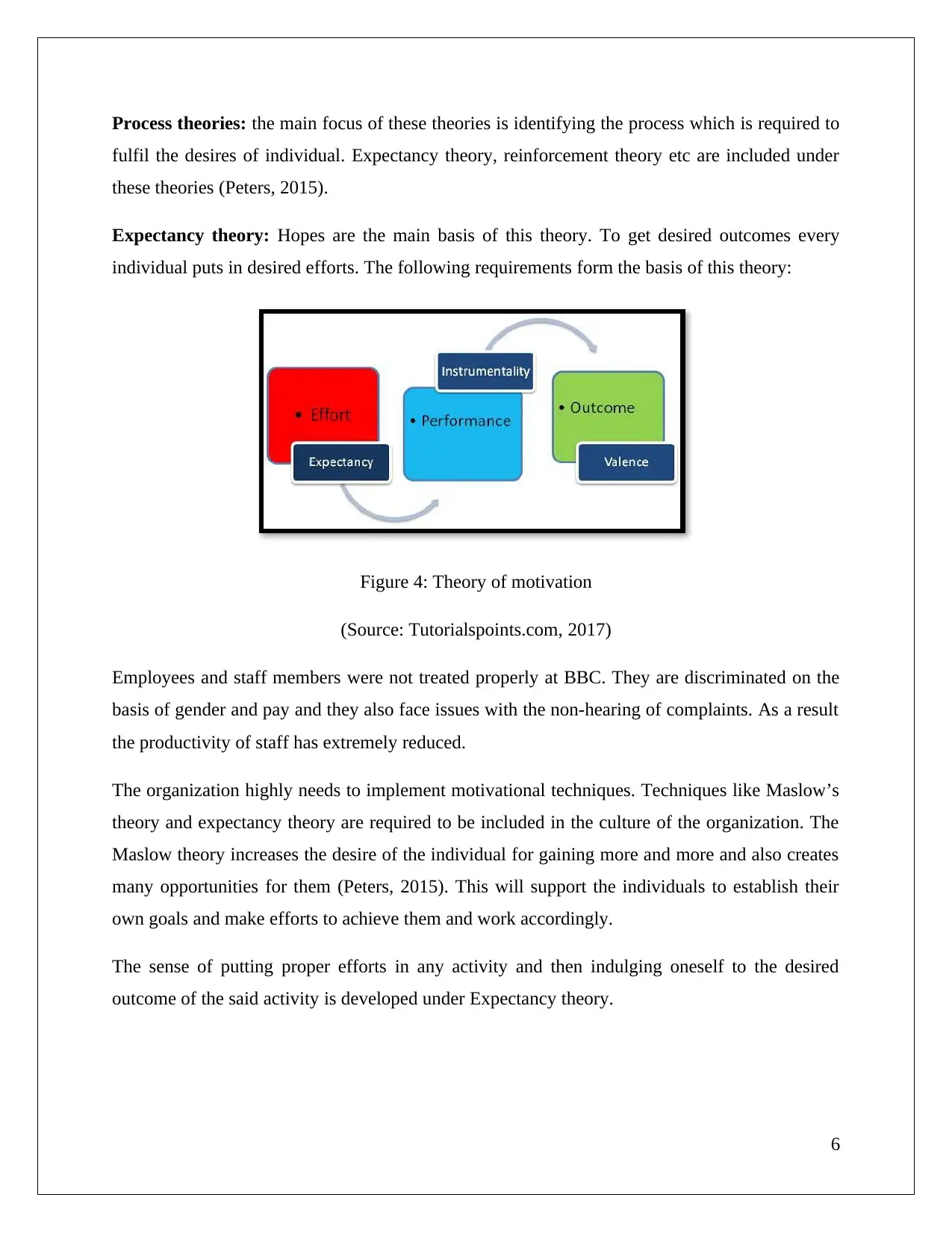
Process theories: the main focus of these theories is identifying the process which is required to
fulfil the desires of individual. Expectancy theory, reinforcement theory etc are included under
these theories (Peters, 2015).
Expectancy theory: Hopes are the main basis of this theory. To get desired outcomes every
individual puts in desired efforts. The following requirements form the basis of this theory:
Figure 4: Theory of motivation
(Source: Tutorialspoints.com, 2017)
Employees and staff members were not treated properly at BBC. They are discriminated on the
basis of gender and pay and they also face issues with the non-hearing of complaints. As a result
the productivity of staff has extremely reduced.
The organization highly needs to implement motivational techniques. Techniques like Maslow’s
theory and expectancy theory are required to be included in the culture of the organization. The
Maslow theory increases the desire of the individual for gaining more and more and also creates
many opportunities for them (Peters, 2015). This will support the individuals to establish their
own goals and make efforts to achieve them and work accordingly.
The sense of putting proper efforts in any activity and then indulging oneself to the desired
outcome of the said activity is developed under Expectancy theory.
6
fulfil the desires of individual. Expectancy theory, reinforcement theory etc are included under
these theories (Peters, 2015).
Expectancy theory: Hopes are the main basis of this theory. To get desired outcomes every
individual puts in desired efforts. The following requirements form the basis of this theory:
Figure 4: Theory of motivation
(Source: Tutorialspoints.com, 2017)
Employees and staff members were not treated properly at BBC. They are discriminated on the
basis of gender and pay and they also face issues with the non-hearing of complaints. As a result
the productivity of staff has extremely reduced.
The organization highly needs to implement motivational techniques. Techniques like Maslow’s
theory and expectancy theory are required to be included in the culture of the organization. The
Maslow theory increases the desire of the individual for gaining more and more and also creates
many opportunities for them (Peters, 2015). This will support the individuals to establish their
own goals and make efforts to achieve them and work accordingly.
The sense of putting proper efforts in any activity and then indulging oneself to the desired
outcome of the said activity is developed under Expectancy theory.
6
Paraphrase This Document
Need a fresh take? Get an instant paraphrase of this document with our AI Paraphraser
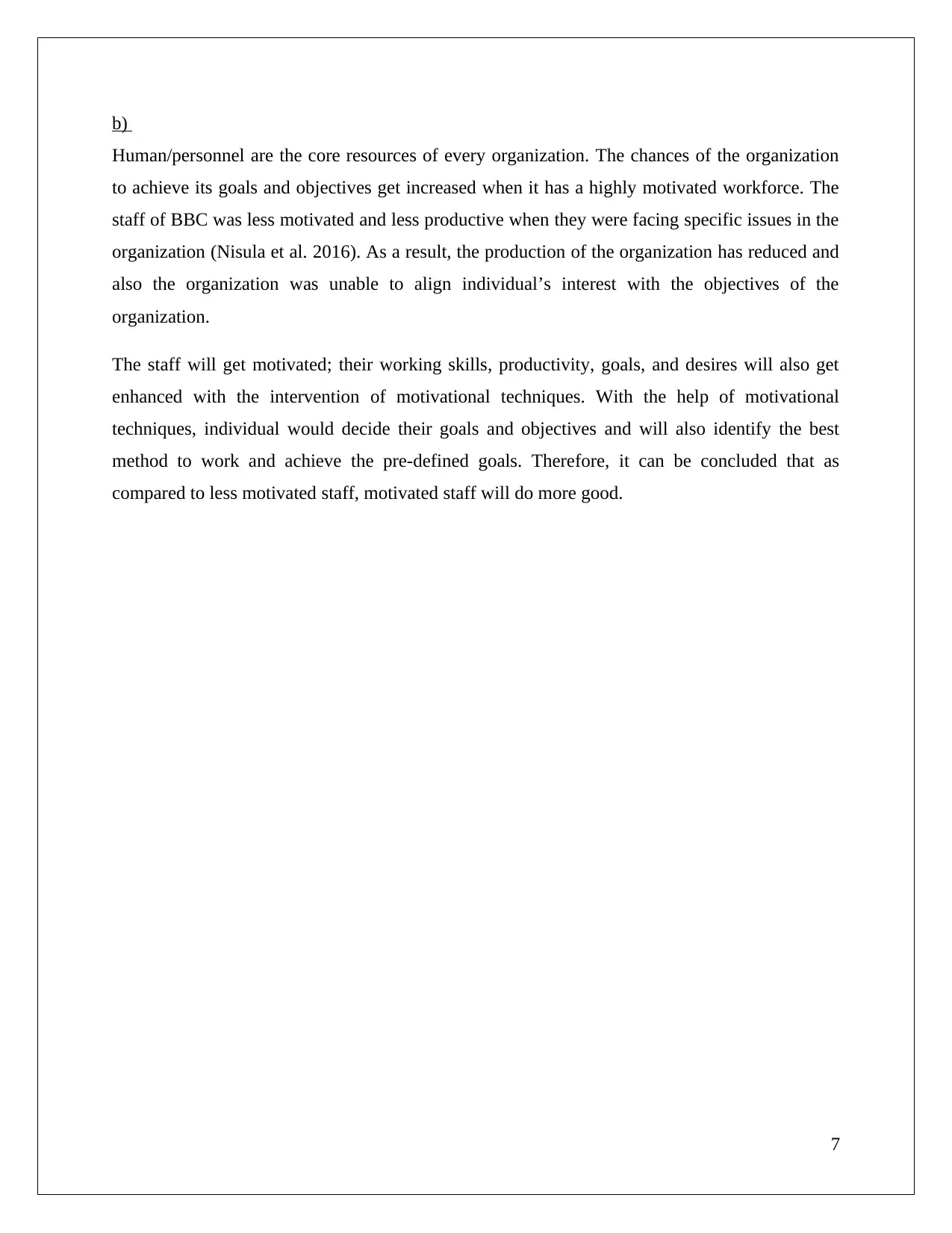
b)
Human/personnel are the core resources of every organization. The chances of the organization
to achieve its goals and objectives get increased when it has a highly motivated workforce. The
staff of BBC was less motivated and less productive when they were facing specific issues in the
organization (Nisula et al. 2016). As a result, the production of the organization has reduced and
also the organization was unable to align individual’s interest with the objectives of the
organization.
The staff will get motivated; their working skills, productivity, goals, and desires will also get
enhanced with the intervention of motivational techniques. With the help of motivational
techniques, individual would decide their goals and objectives and will also identify the best
method to work and achieve the pre-defined goals. Therefore, it can be concluded that as
compared to less motivated staff, motivated staff will do more good.
7
Human/personnel are the core resources of every organization. The chances of the organization
to achieve its goals and objectives get increased when it has a highly motivated workforce. The
staff of BBC was less motivated and less productive when they were facing specific issues in the
organization (Nisula et al. 2016). As a result, the production of the organization has reduced and
also the organization was unable to align individual’s interest with the objectives of the
organization.
The staff will get motivated; their working skills, productivity, goals, and desires will also get
enhanced with the intervention of motivational techniques. With the help of motivational
techniques, individual would decide their goals and objectives and will also identify the best
method to work and achieve the pre-defined goals. Therefore, it can be concluded that as
compared to less motivated staff, motivated staff will do more good.
7

M2
Getting tired and becoming less productive is the tendency of human behaviour. To motivate the
teams of personnel, it is essential to implement various behavioural theories and models.
Expression of human and change in their working can be brought through motivation. When the
employees of an organization are highly motivated, it becomes easy for an organization to
achieve its goals and objectives (Allen et.al. 2016). The implementation motivational theories
will help in the development of management practices which cares for its staff and also will also
help to develop leadership styles in the organization. The staffs and personnel appreciate such
organizational culture.
8
Getting tired and becoming less productive is the tendency of human behaviour. To motivate the
teams of personnel, it is essential to implement various behavioural theories and models.
Expression of human and change in their working can be brought through motivation. When the
employees of an organization are highly motivated, it becomes easy for an organization to
achieve its goals and objectives (Allen et.al. 2016). The implementation motivational theories
will help in the development of management practices which cares for its staff and also will also
help to develop leadership styles in the organization. The staffs and personnel appreciate such
organizational culture.
8
⊘ This is a preview!⊘
Do you want full access?
Subscribe today to unlock all pages.

Trusted by 1+ million students worldwide
1 out of 26
Related Documents
Your All-in-One AI-Powered Toolkit for Academic Success.
+13062052269
info@desklib.com
Available 24*7 on WhatsApp / Email
![[object Object]](/_next/static/media/star-bottom.7253800d.svg)
Unlock your academic potential
Copyright © 2020–2025 A2Z Services. All Rights Reserved. Developed and managed by ZUCOL.





